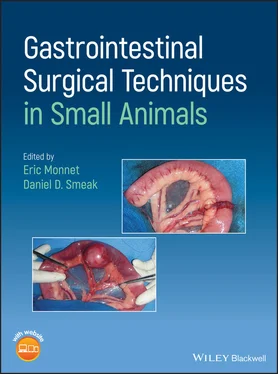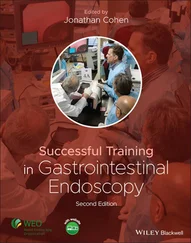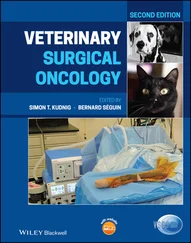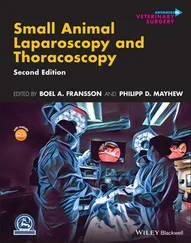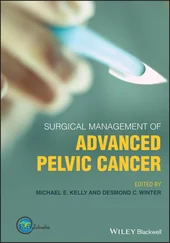Recently, use of directional or barbed suture materials have been documented in gastrointestinal procedures ( Table 2.1) (Hansen and Monnet 2012; Erhart et al. 2013). Barbed sutures are manufactured by making small cuts in the surface of smooth suture, creating spurs. They are specifically designed to be used in continuous suture patterns. The barbs catch within collagenous tissue as each suture pass is taken. Unlike conventional sutures, previously placed tissue bites grab and remain secure in tissue, spreading tension throughout the line. Intestinal anastomosis performed with the unidirectional barbed suture seems to have a higher leakage pressure than anastomosis performed with regular monofilament sutures (Hansen and Monnet 2012). Each suture pass cannot “back out” due to the directional barbs. These sutures make it possible to secure a suture line without a knot. The suture is placed through a loop at the beginning of the suture line and then at the end of the suture line for gastrointestinal surgery two extra bites are made at 180° to lock the suture.
Barbed sutures have tensile strength comparable to their unbarbed equivalents when factoring size by their inner diameter at the depth of the barb cut versus outer diameter of conventional suture (Arbaugh et al. 2013; Ferrer‐Marquez and Belda‐Lorano 2009).
Both unidirectional suture and bidirectional sutures are available. Unidirectional sutures have a loop at one end and a needle on the other. The first needle bite is taken in tissue, and instead of creating a knot, the needle is passed through the loop to secure the end. With bidirectional barbed sutures, barbs are cut toward each end, starting mid‐strand with needles swaged on both ends.
Barbed sutures are more efficient to place than conventional sutures. They have been documented to reduce operative time and in some cases intraoperative bleeding, likely due to maintained consistent tightness throughout the continuous suture line. When used on hollow viscera, bursting pressures were comparable between barbed suture lines and conventional ones (Hansen and Monnet 2012; Erhart et al. 2013). Comparable outcomes following gastric, enteric, and biliary duct repairs using barbed suture have been reported (Denyttenaera et al. 2009). When using barbed suture for intra‐abdominal visceral repair, the exposed rough suture end from the final pass can create adhesion formation and possibly adjacent tissue erosion. It is recommended when terminating barbed suture placed for viscera, two final needle passes in opposing directions should be completed and the end should be cut short against the tissue to avoid excessive adhesion formation.
| Tissue/Procedure |
Suture Recommendations |
Needle Recommendations |
Suture Size Range |
Stapling Equipment, Cartridge Size |
Comments |
| Mucoperiosteal Flap, Cleft Palate, Oronasal Fistula Repair |
Intermediate to prolonged absorbable suture; nonabsorbables are acceptable |
Superficial closures 3/8 circle, deeper closures 1/2 circle; keratinized layers – reverse cutting or taper‐cut (skin, mucoperiosteum, gingiva); 5/8 circle needles may aid in suture placement for deep wounds in confined areas. |
5‐0 for small dogs and cat, 4‐0 larger animals |
NA |
Choose the smallest‐sized suture comfortably possible to minimize trauma from suture placement, and to reduce foreign body reaction. Removal of nonabsorbable sutures can be difficult from deeper regions of the mouth without sedation. |
| Gingiva, Oral Mucosa, Labial, Tongue Repair |
Rapid to intermediate absorbable sutures |
3/8 circle, taper needles for mucosa; taper‐cut for gingiva |
5‐0 for small dogs and cat, 4‐0 larger animals |
NA |
Oral mucosa heals quickly. Be sure knots are firmly and squarely applied since knot ears have a tendency to untie prematurely particularly with multifilament absorbable sutures. |
| Esophagus/Anastomosis, Esophagotomy, Muscular Patch |
Monofilament prolonged absorbable sutures |
3/8 to 1/2 circle taper needle. Deeper layers or hard to reach areas choose 1/2 circle |
4‐0 |
Circular stapling, EEA 21, 25 mm |
Circular stapler size is a limitation for small dogs and cats. Tissue thickness must be more than 1 mm and less than 2.5 mm for proper staple engagement and formation. |
| Stomach wall/Gastrotomy, Gastrectomy, Diversions; Gastric Wall Invagination |
Monofilament, intermediate to prolonged absorbable suture |
1/2 circle, taper needle |
3‐0 to 4‐0 |
Linear stapling GIA (green cartridge) or TA (green cartridge) |
Monocryl, Biosyn, or Maxon are recommended. Polydioxanone loses strength rapidly in acidic environments, so avoid if suture penetrates stomach lumen. |
| Gastropexy |
Monofilament intermediate to prolonged absorbable suture |
1/2 circle, taper needle |
2‐0 to 3‐0 |
Skin stapler (wide); GIA (3.5 mm) |
Larger suture size is recommended due to tension on the gastropexy suture line. Skin staplers have been used successfully for gastropexy. A limited number of dogs have undergone gastropexy using a GIA linear stapler. |
| Pancreas, Marsupialization |
Monofilament, intermediate to prolonged absorbable suture |
1/2 circle, taper needle |
4‐0 |
NA |
|
| Liver/Lobectomy, Partial Lobectomy, Laceration, Biopsy |
Monofilament intermediate absorbable |
3/8 to 1/2 circle, taper |
4‐0 |
Hilar resection TA 30; partial resection TA (3.5 mm) |
Some surgeons prefer multifilament suture for guillotine biopsy. Monofilaments are recommended for laceration repair since smooth surface does not cut friable tissue. Blue linear staple lines may not control all hemorrhage during partial lobectomy; electrocoagulate or skeletonize and ligate remaining bleeders. |
| Common Bile Duct, Gall Bladder/Cholecystotomy, Choledocotomy, Anastomosis |
Monofilament intermediate to prolonged absorbable sutures |
Fine 3/8 to 1/2 circle taper |
4‐0 to 5‐0 |
NA |
Multifilament sutures can be used successfully. Nonabsorbable sutures may act as a nidus of infection or calculus formation. |
| Small Intestine/Anastomosis, Enterotomy, Serosal Patch, Enteroplication |
Monofilament, intermediate to prolonged absorbable suture |
1/2 circle taper needle |
3‐0 to 4‐0 |
GIA (3.5 mm), TA (3.5 mm), skin stapler (regular) |
Multifilament sutures can be successfully used for intestinal surgery but they cause more tissue drag and may potentiate infection in the presence of contamination. Monofilament nonabsorbable sutures are an acceptable alternative. Avoid nonabsorbable sutures in continuous lines because suture migration – linear foreign body formation is possible. |
| Large Intestine/Colotomy, Colostomy, Typhlectomy |
Monofilament, intermediate to prolonged absorbable suture |
1/2 circle taper needle |
3‐0 to 4‐0 |
Circular stapling 21, 25 mm; GIA (3.5 mm), TA (3.5 mm) |
Multifilament sutures can be successfully used for intestinal surgery but they cause more tissue drag and may potentiate infection in the presence of contamination. Monofilament nonabsorbable sutures are an acceptable alternative. Circular stapler size is a limitation for small dogs and cats. Tissue thickness must be more than 1 mm and less than 2.5 mm for proper staple engagement and formation. |
| Colopexy |
Monofilament prolonged absorbable suture |
1/2 circle taper needle |
2‐0 to 3‐0 |
NA |
Larger suture size is recommended due to tension on the colopexy suture line. |
| Rectum/Partial Resection, Anastomosis |
Monofilament, intermediate to prolonged absorbable suture |
1/2 circle taper needle |
3‐0 to 4‐0 |
Circular stapling 21, 25 mm (3.5 to 4.8 mm) |
Multifilament sutures can be successfully used for intestinal surgery but they cause more tissue drag and may potentiate infection in the presence of contamination. Monofilament nonabsorbable sutures are an acceptable alternative. Circular stapler size is a limitation for small dogs and cats. Tissue thickness must be more than 1 mm and less than 2.5 mm for proper staple engagement and formation. |
| Anus/Anal Mass Resection, Mucosal Repair |
Rapid to intermediate absorbable sutures |
3/8 to 1/2 circle taper or taper‐cut |
4‐0 |
NA |
Healing of anal mucosa is rapid, so intermediate absorbable sutures are preferred. Multifilament sutures may not irritate sensitive anal mucosa compared to more rigid multifilament knot ears. |
NA = Not Applicable.
